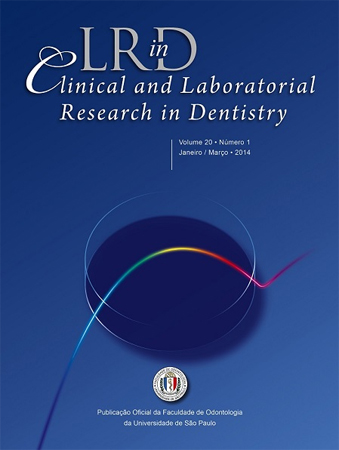Efeito da radiação ionizante no desenvolvimento de lesões de cárie em dentes humanos in vitro
DOI:
https://doi.org/10.11606/issn.2357-8041.v20i1p46-53Palavras-chave:
Cárie Dentária, Neoplasias de Cabeça e Pescoço, Radioterapia, Streptococcus mutans.Resumo
A radioterapia é associada a diversos efeitos colaterais, entre eles a cárie de radiação. O objetivo desse estudo foi avaliar o efeito da radiação ionizante no desenvolvimento de lesões cariosas utilizando um sistema bacteriano in vitro. Foram selecionados quinze terceiros molares humanos inclusos que foram seccionados em fragmentos vestibular (A, controle) e lingual (B, irradiado), e foram mantidos pareados até o término do estudo. O grupo B foi submetido à radioterapia de acordo com protocolo utilizado no tratamento radioterápico de cabeça e pescoço. Ambos os grupos foram expostos a um desafi o cariogênico utilizando um sistema bacteriano com S. mutans por 10, 20 e 30 dias (n = 5). As variáveis de profundidade, extensão e área das lesões formadas no limite amelo-dentinário foram medidas por um software acoplado ao microscópio de luz. A Tomografi a de coerência óptica (TCO) foi utilizada para visualizar as características morfológicas das lesões. Os resultados da microscopia de luz mostraram que, no período de 20 dias de desafi o bacteriano, ocorreu um resultado signifi cante, comparando a profundidade das lesões formadas entre os grupos A e B (p = 0.013). A análise de TCO não permitiu visualizar as camadas de cárie das lesões. Podemos concluir, dentro das limitações do estudo, que o tratamento radioterápico pode levar à formação de lesões de cárie mais profundas do que aquelas que se desenvolvem em dentes sem exposição à radiação ionizante.Downloads
Referências
Brazil. Ministry of Health. National Institute of Cancer
José Alencar Gomes da Silva. Estimate/2012 - Cancer Incidence in Brazil [Internet]. Rio de Janeiro: Inca; 2011 [cited 2013 May 23]. Available from: URL:http://www.saude.sp.gov.
br/resources/ses/perfil/gestor/homepage/estimativas-deincidencia-de-cancer-012/estimativas_incidencia_cancer_
pdf.
Moore S, Burke MC, Fenlon MR, Banerjee A. The role of
the general dental practitioner in managing the oral care
of head and neck oncology patients. Dent Update. 2012
Dec;39(10):694-6,698-700,702.
Thariat J, Ramus L, Darcourt V, Marcy PY, Guevara N, Odin G, et al. Compliance with fluoride custom trays in irradiated head and neck cancer patients. Support Care Cancer. 2012 Aug;20(8):1811-4.
Aguiar GP, Jham BC, Magalhães CS, Sensi LG, Freire AR.
A review of the biological and clinical aspects of radiation
caries. J Contemp Dent Pract. 2009 Jul 1;10(4):83-9.
Jham BC, da Silva Freire AR. Oral complications of radiotherapy in the head and neck. Braz J Otorhinolaryngol.2006 Sep-Oct;72(5):704-8.
Meurman JH, Grönroos L. Oral and dental health care of oral cancer patients: hyposalivation, caries and infections. Oral Oncol. 2010 Jun;46(6):464-7.
Springer IN, Niehoff P, Warnke PH, Böcek G, Kovács G, Suhr M, et al. Radiation caries--radiogenic destruction of dentalcollagen. Oral Oncol. 2005 Aug;41(7):723-8.
Jham BC, Reis PM, Miranda EL, Lopes RC, Carvalho AL,
Scheper MA, et al. Oral health status of 207 head and neck
cancer patients before, during and after radiotherapy. Clin
Oral Investig. 2008 Mar;12(1):19-24.
Silva AR, Alves FA, Antunes A, Goes MF, Lopes MA. Patterns of demineralization and dentin reactions in radiation-related caries. Caries Res. 2009;43(1):43-9.
Silva AR, Alves FA, Berger SB, Giannini M, Goes MF, Lopes MA. Radiation-related caries and early restoration failure in head and neck cancer patients. A polarized light microscopy and scanning electron microscopy study. Support Care Cancer. 2010 Jan;18(1):83-7.
Poyton HG. The effects of radiation on teeth. Oral Surg Oral Med Oral Pathol. 1968 Nov;26(5):639-46.
Anneroth G, Holm E, Karlsson G. The effect of radiation on teeth. A clinical, histologic and microradiographic study. Int J Oral Surg. 1985 Jun;14(3):269-74.
Fränzel W, Gerlach R. The irradiation action on human dental tissue by X-rays and electrons -- a nanoindenter study. Z Med Phys. 2009;19(1):5-10.
Gama-Teixeira A, Simionato MR, Elian SN, Sobral MA,
Luz MA.Streptococcus mutans-induced secondary caries adjacent to glass ionomer cement, composite resin and
amalgam restorations in vitro. Braz Oral Res.2007 Oct-
Dec;21(4):368-74.
Espejo LC, Simionato MR, Barroso LP, Netto NG, Luz MA. Evaluation of three different adhesive systems using a bacterial method to develop secondary caries in vitro. Am J Dent. 2010 Apr;23(2):93-7.
Azevedo CS, Trung LC, Simionato MR, Freitas AZ, Matos AB. Evaluation of caries-affected dentin with optical coherence tomography. Braz Oral Res. 2011 Sep-Oct;25(5):407-13.
L ee C, Darling CL, Fried D. Polarization-sensitive optical
coherence tomographic imaging of artificial demineralization
on exposed surfaces of tooth roots. Dent Mater.
Jun;25(6):721-8.
Maia AM, Fonsêca DD, Kyotoku BB, Gomes AS. Characterization of enamel in primary teeth by optical coherence tomography for assessment of dental caries. Int J Paediatr Dent. 2010 Mar;20(2):158-64.
Specht L. Oral complications in the head and neck radiation patient. Introduction and scope of the problem. Support Care Cancer. 2002 Jan;10(1):36–9.
Downloads
Publicado
Edição
Seção
Licença
Solicita-se aos autores enviar, junto com a carta aos Editores, um termo de responsabilidade. Dessa forma, os trabalhos submetidos à apreciação para publicação deverão ser acompanhados de documento de transferência de direitos autorais, contendo a assinatura de cada um dos autores, cujo modelo está a seguir apresentado:
Eu/Nós, _________________________, autor(es) do trabalho intitulado _______________, submetido agora à apreciação da Clinical and Laboratorial Research in Dentistry, concordo(amos) que os autores retém o direitos autorais e garantem a revista o direito da primeira publicação, sendo o trabalho simultaneamente autorizado sob a Creative Commons Attribution License, que permite a outros compartilhar o artigo com reconhecimento da autoria do trabalho e publicação inicial nesta Revista. Aos autores será possibilitada a distribuição em separado da versão publicada do artigo, arranjos contratuais adicionais para a distribuição não-exclusiva da versão publicada (por exemplo, publicá-la em um repositório institucional ou publicação em livro), com o reconhecimento de sua publicação inicial nesta revista. Aos autores será permitido e encorajado publicar seu trabalho on-line (por exemplo, em repositórios institucionais ou em seu site) antes e durante o processo de envio, pois pode levar a intercâmbios produtivos, bem como a maior citação do trabalho publicado. (Veja The Effect of Open Access).
Data: ____/____/____Assinatura(s): _______________


